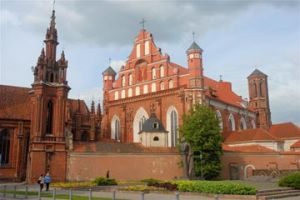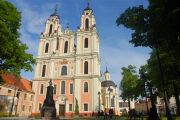 |
 |
Vilnius, a city with a rich heritage |
 |
 |

|
 Saint Francis and Bernardine church © T. Joly Saint Francis and Bernardine church © T. Joly

|
Famous for its baroque monuments and lovely churches, Vilnius boasts one of the largest surviving
medieval neighbourhoods in Eastern Europe and is the 2009 European Capital of Culture.
This easy going city has a rich cultural life and offers many night entertainments.
[ Practical ]
- Getting there
At the moment there is no direct flight between Paris and Vilnius.
Austrian Airlines, Lot Polish Airlines, Lufthansa, Czech Airlines, SAS Scandinavian Airlines and Air Baltic have flights via Vienna, Warsaw, Frankfurt, Prague, Copenhagen and Riga. Journey takes around 4 hours 30 minutes.
- Lodging
Novotel Vilnius
Radisson Astorja Hotel
Artis Centrum Hotel
Ramada Vilnius
Klaipeda Hotel
Domus Maria
Bernardinu B&B House
Litinterp B&B
- Restaurants
Lokys
Uzupio Kavine
Zemaiciai
Cili
- Going out
Brodvejus
Broadway
Lietuvos Clubas
The Dubliner
- Getting around
Most of the sights are within walking distance of the Old Town as well as the bus and the train stations. An excellent bus and trolley bus network takes you everywhere else including to the airport. Buses and trains serve Trakai, Kaunas and Kernave.
- Good to know
A 3 days / 2 nights allows to see the main sights but if you also wish to visit Trakai a 4 days / 3 nights stay is better. Allow 300 to 350 € per person for a 4 days / 3 nights stay in a double room with breakfast in a 3* hotel and flights included.
- Travel Companies
In France
Amslav, CGTT, Donatello, Kuoni, Jet Tours, Slav’Tours, Voyageurs du Monde.
In Vilnius
Taiga Euro Baltika
Tel : (370) 5 2121388, office@taigaeurobaltika.com, www.taigaeurobaltika.com
- Information
Lithuania tourist office
72 rue Pierre Demours, 75017 Paris
Tel : 0146225384
www.lithuaniatourism.co.uk
For the first time this year, a city of one of the States which have joined the European Union in 2004 has been designed European Capital of Culture. This honour goes to Vilnius, the capital of Lithuania, the largest of the Baltic States. All around the year many cultural events will come in addition to the usual ones such as the Music Festival and the Jazz Festival held in June and October.
 Well-preserved historical centre Well-preserved historical centre
That’s an excellent reason to go and discover this city founded in the 14th century that boasts a remarkably well-preserved historical centre listed as World Heritage by Unesco. Crisscrossed by winding, narrow medieval cobble-stoned streets where it is enjoyable to stroll, this neighbourhood counts many gothic, Renaissance, Baroque buildings and even a few neoclassic ones such as the city hall and the Presidential Palace. But it’s not only an open-air museum. Numerous bars and restaurants are open and busy till late and as soon as sun appears customers invade the terraces in an easy going and festive atmosphere.
The diversity of the buildings bears witness of the country glorious history. From the end of the 13th century till the end of the 16th it was one of the largest and most powerful kingdom in Eastern Europe and Vilnius kept flourishing after it lost its independence. Saint Anne’s Church is thus a masterpiece of Lithuanian Gothic architecture with an elaborate facade made up of thirty-three kinds of red bricks composing arches, intricate patterns and three graceful towers.

 Sainte Catherine's church © T.Joly Sainte Catherine's church © T.Joly
|
 Numerous Baroque churches Numerous Baroque churches
Another fine example of gothic architecture, the nearby Saint Francis and Saint Bernardine church is dotted with a gabled façade and houses superb ornate tombstones as well as unique mural painting dating back to the 16th century.
Founded by the Jesuits in 1579, the University is one of the oldest in Eastern Europe and its twelve faculties and eight institutes are arranged around thirteen inner courtyards all of different shapes and styles. Hosting more than 25 000 students, it looks like a city within a city and has a remarkable church dedicated to Saint John of which the belfry is the tallest building of the Old Town. It is one of the many baroque churches built at the time of the Counter Reformation by noblemen willing to be forgiven for their tolerance towards the Protestants. Today, it owes Vilnius to be sometimes called a baroque city. The most beautiful is Saint Peter and Paul. Built in the 17th century, it looks rather austere from the outside but the interior walls are crowded with over 2 000 stucco mouldings of biblical, historical, allegorical and mythological figures, plants and animals. Under the Soviet rule it was one of the only churches that remained open for the cult and nowadays it is a very popular place to get married.
 Miracle icon Miracle icon
There are also a few Orthodox and Protestant ones but Lithuanian people are mainly Catholics and their faith can be best seen in two places. The chapel located above the Gates of Dawn, the former Vilnius Eastern gate, where pilgrims and worshippers come to see the Mother of Mercy icon, renowned for its healing power. The imposing cathedral of classic style, the country main church, where one can sometimes visit a beautiful baroque chapel dedicated to Saint Casimir, the patron Saint of Lithuania. Besides, in sharp contrast, stands its belfry, originally a tower that was part of a medieval fortified compound. It also included the Gediminas tower that tops the nearby hill and offers a panoramic view of the city. Downhill the 16th century Palace of the Grand Dukes of Lithuania is being rebuilt exactly as it was before being destroyed. It will be inaugurated in July to celebrate the country 1000th anniversary. That’s indeed in the year 1009 that a manuscript first mentioned the existence of a Lithuanian kingdom. In front of the cathedral begins the Champs Elysees of Vilnius, the large Gediminas Avenue.
 Bohemian neighbourhood Bohemian neighbourhood
Showcase of the modern town, it is lined with former palaces, trendy bars and restaurants, hotels, fashion shops and official buildings. If you look carefully at the one housing the Government Archives you will notice that some of the wall stones bear the names of heroes who died while defending the city against the Soviet invasion in 1945. Set up nearby in the former KGB headquarters, the Genocide Victims Museum reminds that the Lithuanian people paid a heavy price for their independence desire. Between 1945 and 1953 more than 40 000 of them were killed while fighting the Soviets and another 500 000 were deported to Siberia. And before that roughly one third of the population died during the Second World War. In spite of that their will was never broken and Lithuania was the first country to split away from former Soviet Union in 1990. From then, people live life to its fullest and enjoy their regained freedom. A rebirth symbolized by the bohemian Uzupis neighbourhood where one can find galleries, restaurants and cafes including few ones lovely nested by the river Vilnia. In 1997 it declared itself a republic governed by artists and romantics and has its own president, ministers and constitution !!!
 A night in a kolkhoze A night in a kolkhoze
However, even in Vilnius recollections from the past are still clearly visible : crumbling soviet style buildings, old looking buses and babouchkas going to the central market to sell some vegetable in order to top up their meagre pension. If you want to get a glimpse of what was life in the Communist era the travel company Taiga Euro Baltika offers an interesting and amusing experience. To spend the night in a former kolkhoze located in Kernave, 50 km west of Vilnius. It is believed that the country have been united for the first time in this village in 1253. It is surrounded by beautiful scenery where archaeologists have discovered evidence of dwellings dating back to more than 10 000 years and several fortified hills once protecting a medieval town.
So this site occupies a particular place in the heart of Lithuanian people. As does the country second largest city, Kaunas, that was its capital when it briefly regained its independence between 1920 and 1939. A baroque city hall, medieval towers and 15th century German merchant houses compose an historical centre worth a detour.
 Fairy tale castle Fairy tale castle
Moreover there are an interesting Fine Arts Museum and a quaint museum devoted to works picturing the Devil while the outskirts boast the charming Pazaisilis Monastery of Venetian baroque style. Kaunas is only 80 km from Vilnius and so easy to visit in one day.
But if you plan to do only one excursion outside the Lithuanian capital, don’t hesitate. Go to Trakai. Only 30 km away, this charming village was briefly the Kings residence in the 14th century when the Teutonic Knights posed a threat to the country. Located at the junction of several lakes it boasts colourful wooden houses built by the Karaites, a Jewish minority originating from the shores of the Black Sea that once formed the personal guard of the Grand Dukes of Lithuania. The rulers used to live in what is now the most pictured monument of Lithuania. A powerful red brick castle built on an island which has never been conquered by the enemies. Restored in the 60’s it reflects itself in the waters of the Lake Gave like a fairy tale sight and is an unforgettable souvenir of Lithuania.
May 06, 2016
Thierry Joly 

|
|
 |

|
 |



